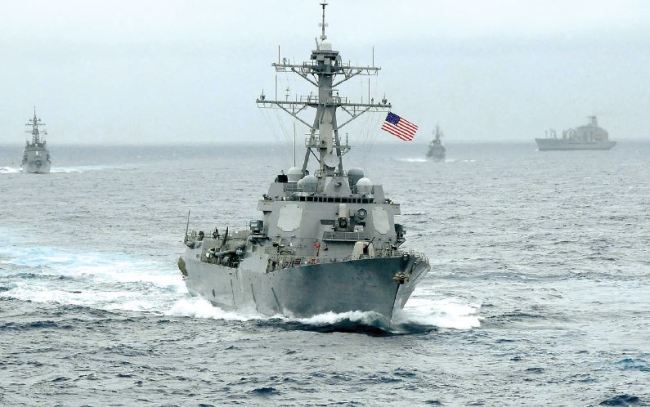Cheong Wa Dae on Wednesday urged for a peaceful resolution to escalating tensions between the U.S. and China over territorial disputes in the South China Sea.
“South Korea has been strongly calling for restraint of any action that affects peace and stability in the region through various channels including global forums,” a senior official at the presidential office told reporters. “Disputes should be resolved in accordance with international norms.”
 |
The U.S. Navy guided-missile destroyer USS Lassen sails in the Pacific Ocean in a November 2009 photo provided by the U.S. Navy. The U.S. Navy sent a guided-missile destroyer within 12 nautical miles of artificial islands built by China in the South China Sea on Tuesday, a U.S. defense official said, in a challenge to China`s territorial claims in the area. (Reuters-Yonhap) |
The Cheong Wa Dae official also stressed that South Korea has a “strategic interest” in the South China Sea, saying that it is a key shipping route through which 30 percent of the country’s exports and 90 percent of its energy shipments pass.
The remark, seen as South Korean diplomatic rhetoric, appeared to be reiterating its neutral stance over intensifying disputes between the U.S. and China.
Seoul has been under growing pressure from Washington to clarify its position over China’s territorial claims in the area and support the U.S. if it takes actions to challenge Beijing. At a summit with Park two weeks ago, Obama said that Washington expects Seoul to speak out if China fails to abide by international norms and rules. Speculations grew fast here that Washington was nudging Seoul over China’s land reclamation projects while flaunting their renewed alliance.
Seoul expressed its position a day after a U.S. navy destroyer sailed past one of China’s artificial islands in the South China Sea, which Beijing denounced as a “deliberate provocation.”
China’s Foreign Ministry said its officials monitored and warned the USS Lassen as it passed what China claims is a 21-kilometer territorial limit around the Subi Reef in the Spratly Islands archipelago. The U.S. had signaled for weeks that it would undertake the mission to exercise the right to navigate freely in international waters, though it appears to have taken to pushing back against China’s growing assertiveness.
China warned that it would not condone any actions that undermine its security.
China has built the reef into an island by piling sand atop using dredgers, according to satellite images. The building program appears to be an infrastructure project to construct a runway capable of accommodating aircraft.
Washington has warned that China’s artificial islands cannot be considered sovereign territory along with the right to claim the surrounding territorial waters.
Under international law, military vessels are permitted to pass in the course of transiting through other country’s seas without notification.
By Cho Chung-un (
christory@heraldcorp.com)








![[Today’s K-pop] Blackpink’s Jennie, Lisa invited to Coachella as solo acts](http://res.heraldm.com/phpwas/restmb_idxmake.php?idx=644&simg=/content/image/2024/11/21/20241121050099_0.jpg)